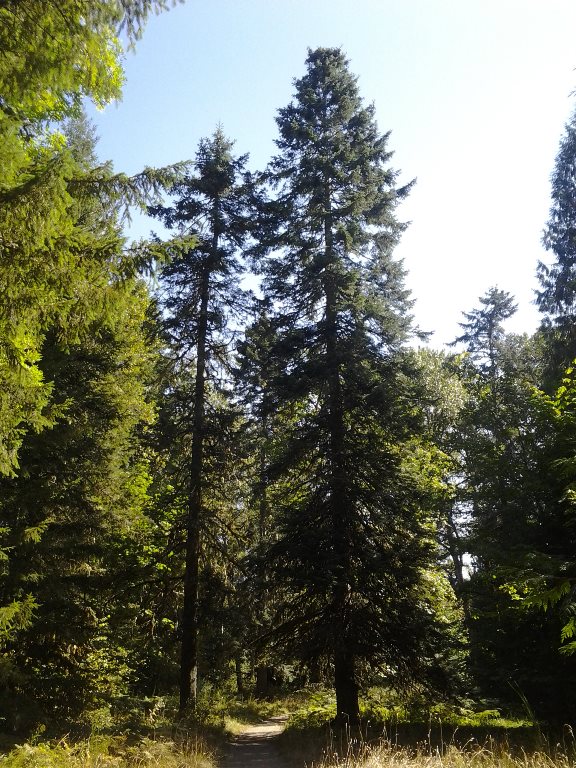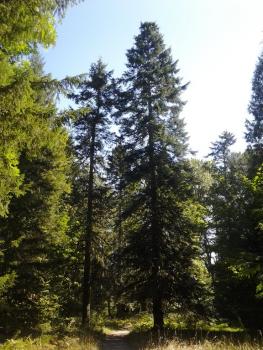Grand Fir (Abies grandis)

Common Name(s): Grand fir, balsam fir, lowland white fir, Puget Sound fir, Oregon white fir, silver fir, yellow fir.
Scientific Name(s): Abies grandis
Island Hulkemel'em Name(s): t’a'xwulhp (up/down river)
Family: Abies
Cautions: None
Botanical Description: Grand fir is a rapidly growing evergreen tree which can reach 75-100 m in height. The bark is smooth and grey, becoming furrowed and brown as the tree ages. Grand fir has needles which grow 2-6 cm in length, have a citrus-like scent, and are spread apart so that both the upper and lower sides of the branch are clearly visible. The needles lie flat on twigs and have blunt tips, with two white stripes on the underside. The cones are 5-10 cm long, cylindrical and yellow in colour when mature.[1]

Current Distribution and Local Habitat(s): Grand fir grows in moist areas, such as stream bottoms, valleys, and lower mountain slopes. It is common in mixed coniferous forests and is shade tolerant. It is found all along the West coast of North America, from coastal British Columbia to Sonoma County, California. There is also a population in the Northern Rocky Mountains in southern British Columbia and Alberta, Washington, Oregon, Idaho and Montana. Compared to subalpine fir, grand fir grows at lower elevations.[2]
Ethnobotanical Application(s): The aromatic properties of Abies grandis were especially useful for different First Nations living in their range. Medicinally, teas were made for colds, crushed and dried needles were used as baby powder, and boughs were brought inside to burn as incense and ward off illness. Pitch (sap) could be mixed with oils and used as a deodorant or to prevent hair loss. The needles were crushed and mixed with tree bark to make a tonic which could aid internal injuries. Materially, the Kwakwakawak shamans wove the branches of grand fir into headdresses and costumes. The Salish used the bark to make a brown dye, and along with the Ditidaht and other coastal groups grand fir knots were steamed, shaped and carved into fish hooks. The Okanagan groups used the wood of the grand fir to make canoes and paddles.[3]
Grand Fir Infused Ice Cream Recipe (adapted from Nootka Rose Petal Ice Cream):
Milk - 2 Cups
Grand Fir needles or shoots (fresh, unsprayed) - 2 Cups
Egg yolks - 6
Sugar - 1 Cup
Whipping cream - 2 Cups
Directions: [4]
1. Combine the milk and fir needles in a saucepan and bring to a boil over medium heat.
As soon as the milk boils, remove the pan from the heat; let stand for 10 minutes.
2. Stir together the egg yolks and sugar in a medium bowl.
3. Strain the milk into the yolk mixture, stirring to mix.
4. Discard the needles and wipe out the pan if necessary.
5. Return the mixture to the saucepan and cook over medium-low heat until the custard is thick enough to coat the back of a spoon, 5-7 minutes. Do not let the custard boil or it will curdle.
6. Let the custard cool slightly, then refrigerate until chilled.
7. Stir in the chilled cream, pour the mixture into an ice-cream maker and freeze according to the manufacturer's instructions.
8. Transfer the frozen ice cream to an airtight freezer container and freeze for at least 1 hour before serving.
**If you don’t have an ice cream maker, place the mixture in a pre-chilled shallow pan or large bowl in the freezer. Take it out every 20-30 minutes and mix it. You will notice that the edges will start to freeze. Continue to mix these frozen bits into the mixture until the whole mix has the texture of soft frozen yogurt (about 3 hours). Then you may leave it in the fridge for 8 hours before your ice cream is finished.**
UVic Campus Location(s): Finnerty Ravine, South Woods, Cunningham Woods, Mystic Vale, Bowker Creek.
Figure Reference(s):
Figure 1: http://nativeplantspnw.com/grand-fir-abies-grandis/
Figure 2: http:// ibis.geog.ubc.ca/biodiversity/eflora/
[1] Washington Native Plant Society. 2007. Grand fir: Abies grandis. Retrieved from http://www.wnps.org/landscaping/herbarium/pages/abies-grandis.html June 20, 2016
[2] USDA: NRCS. 2016. Grand fir Plant Guide. Retrieved November 9, 2016, from https://plants.usda.gov/plantguide/pdf/pg_abgr.pdf
[3] First Voices (2013). Retrieved from http://www.firstvoices.com/ on June 22, 2016
[4] Canadian Recipes (n.d) Nootka Rose Petal Ice Cream. IFOOD. Retrieved from http://ifood.tv/ice-cream/252728-nootka-rose-petal-ice-cream on June 20, 2016.
Project Status:
Date Completed:
Year:
Associated Projects:
Image:

